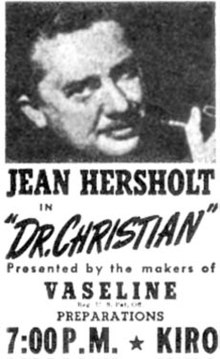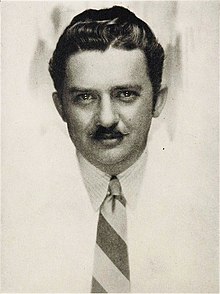|
Jean Hersholt
Jean Pierre Carl Buron (12 July 1886 – 2 June 1956), known professionally as Jean Hersholt, was a Danish-American actor. He is most famous for starring on the CBS radio series Dr. Christian from 1937–1954, which later inspired a TV series with the same name from 1956-1957. He also co-starred with Shirley Temple in the film Heidi (1937).[2] When asked how to pronounce his name, he told The Literary Digest, "in English her'sholt; in Danish, hairs'hult."[3] From 1924 to 1955, he had 140 motion picture credits: 75 silent film and 65 "talkies"; he directed four. Early lifeHersholt was born Jean Pierre Carl Buron on 12 July 1886 in Copenhagen, the capital of Denmark. He claimed to have been born into a family of actors,[4] but in reality, both of his parents, Henri Pierre Buron and Clara (née Petersen), were hairdressers. Henri was the son of a French Roman Catholic father and a Danish Protestant mother, while Clara was the daughter of a Danish Protestant father and a Danish Jewish mother. Initially, Henri worked as a hairdresser but later became a cigar and wine merchant/vendor.[5] Hersholt appeared in two of the first short films of the Danish film studio Nordisk Film in 1906, but did not find much success in his early years in Denmark.[6] Hersholt emigrated to the United States in 1913, and spent the remainder of his acting career in America. Career Hersholt is best remembered for his roles in two iconic films. In 1924, he played Marcus Schouler in the silent film classic Greed directed by Erich von Stroheim. A decade later, he co-starred with world-famous child actress Shirley Temple as her beloved grandfather living in the remote Alps in the 1937 film version of the classic 1880 children's book, Heidi, written by Swiss author Johanna Spyri. Throughout his extensive film career, he portrayed a wide range of characters, from villains in early silent films to supporting roles where his gentle Danish language accent and pleasant voice made him well-suited to portray a succession of benevolent fathers, doctors, professors, and European noblemen. Hersholt's final on-screen appearance was in the 1955 movie Run for Cover.[7] In the 1936 movie The Country Doctor, starring the famous Dionne quintuplets children, Hersholt portrayed Dr. John Luke, a character based on Dr. Allan Roy Dafoe, the Canadian obstetrician who delivered and cared for the Dionne quintuplets. Two sequels followed the movie. Hersholt wanted to portray the role on radio but could not obtain the rights. He chose to create his own doctor character for radio. Since he was a fan of fairy tale anthology author Hans Christian Andersen, he borrowed that name for his character portrayal. This character, "Dr. Paul Christian," was a philosophical doctor who practiced in the typical Midwestern town of River's End. He received assistance from Nurse Judy Price and occasionally from others. On 7 November 1937, Dr. Christian debuted on the Columbia Broadcasting System (CBS) radio network as part of the 'Vaseline Program' opening with the theme music, "Rainbow on the River." The small-town physician's good humor, innate common sense, and scientific training helped drive off a series of villainous types attempting to disrupt the peaceful lifestyle of River's End. The radio series, produced by Dorothy McCann, became a popular long-running hit. It aired on the CBS network for 17 years until 6 January 1954. Hersholt was so strongly associated with the role that he received mail asking for real-life medical advice. The Dr. Christian series spawned several spin-offs, making it one of the earliest media franchises. For example, Hersholt co-wrote a Dr. Christian novel and starred in a series of six family feature films as Dr. Christian in a franchise spanning two years, from 1939 to 1941. An example of one of these films is Dr. Christian Meets the Women released in 1940. In 1956, two years after the long-running radio program concluded, the character Dr. Christian made the transition to television and its unique programming style. The script for this new television program was written by a young Gene Roddenberry, who would later become famous for creating the original TV series 'Star Trek' in 1966. This led to the renowned science fiction franchise over the next few decades. The new 'Dr. Christian' TV show differed from the radio series by introducing a new younger character portrayed by Macdonald Carey as the elder Christian's nephew, "Dr. Mark Christian". The show was syndicated through CBS and its production company, Ziv Television, and ran for two seasons from 1956-1957. It was mostly broadcast at non-traditional times on local stations nationwide, after Jean Hersholt's death in early 1956. From the late 1930s through the mid 1950s, Neil Reagan, the brother of actor and future U.S. president Ronald Reagan, worked as a traveling industry spokesman for the General Electric Company. Additionally, Neil directed the earlier CBS radio series Dr. Christian, with Jean Hersholt. In 1939, Hersholt broadened his social interests and played a critical role in establishing the Motion Picture Relief Fund, now known as the Motion Picture and Television Fund. This fund provides medical care and support for Hollywood industry employees at various levels, offering assistance when experiencing difficulties due to illness, old age, or other challenges. This occurred just four years after the establishment of America's "social safety net" with the passage of Social Security old age pension system by the Roosevelt administration. The fund Hersholt supported was used to establish the Motion Picture Country House and Hospital in Woodland Hills, California. After his death in 1956, his philanthropic endeavors led to the establishment of the Jean Hersholt Humanitarian Award. This honorary Academy Award, also known as the "Oscar," is presented to an "individual in the motion picture industry whose humanitarian efforts have brought credit to the industry." The fund was later expanded to include those working in the television field.[8] As president of the Academy of Motion Picture Arts and Sciences, Hersholt was actively involved in various activities to promote and preserve American cinema. On March 20, 1948, during the 20th anniversary of the academy's founding, he presented special awards to several pioneers of the American motion pictures/film industry. The recipients included Colonel William N. Selig, Albert E. Smith, George K. Spoor, and Thomas Armat. These individuals were often referred to as "the Men Who Invented Hollywood".[9] Hersholt's extensive collection of books and other materials by the famous Danish author Hans Christian Andersen is now housed in the special collections division of the Library of Congress in Washington, D.C.. He translated over 160 of Andersen's fairy tales into English. These were published in 1949 in six volumes as The Complete Andersen, this work is "... rated as The standard translation, being one of the best" in English cited by the Hans Christian Andersen Center of the University of Southern Denmark.[10] Hersholt was appointed a knight of the Danish Order of the Dannebrog and awarded a medal in 1948, partly due to this literary academic endeavor.[11] On August 31, 1952, the accomplished elder Hersholt appeared as the mystery guest on the popular long-running CBS-TV panel/quiz show What's My Line? less than four years before his death. The show aired from the 1950s and into the 1960s and was hosted by John Charles Daly. FamilyHersholt married Via Andersen on 11 April 1914. They had one son, Allan Hersholt. He was the paternal half-uncle (by marriage) of actor Leslie Nielsen and former Canadian Deputy Prime Minister Erik Nielsen.[12] Death Hersholt died of cancer in Hollywood in 1956 and is interred in Forest Lawn Memorial Park Cemetery in Glendale, California. His grave is marked with a statue of Klods-Hans (English: Clumsy Hans), a Hans Christian Andersen character who left home to find his way in the world — much as Hersholt himself had done.[13] Honors and awardsHersholt was honored for his services to the industry three times with an honorary Academy Award, first in 1940 and the second time in 1949 and the third time in 1950.[14] In his honor, the Jean Hersholt Humanitarian Award was named by the Academy of Motion Picture Arts and Sciences.[15] He is one of only 11 people with two stars on the Hollywood Walk of Fame. One is located at 6501 Hollywood Boulevard for his work in motion pictures, and another one is located at 6701 Hollywood Boulevard for his work in radio.[citation needed] Selected filmographyRadio appearances
References
External linksWikimedia Commons has media related to Jean Hersholt.
|
||||||||||||||||||||||||||
